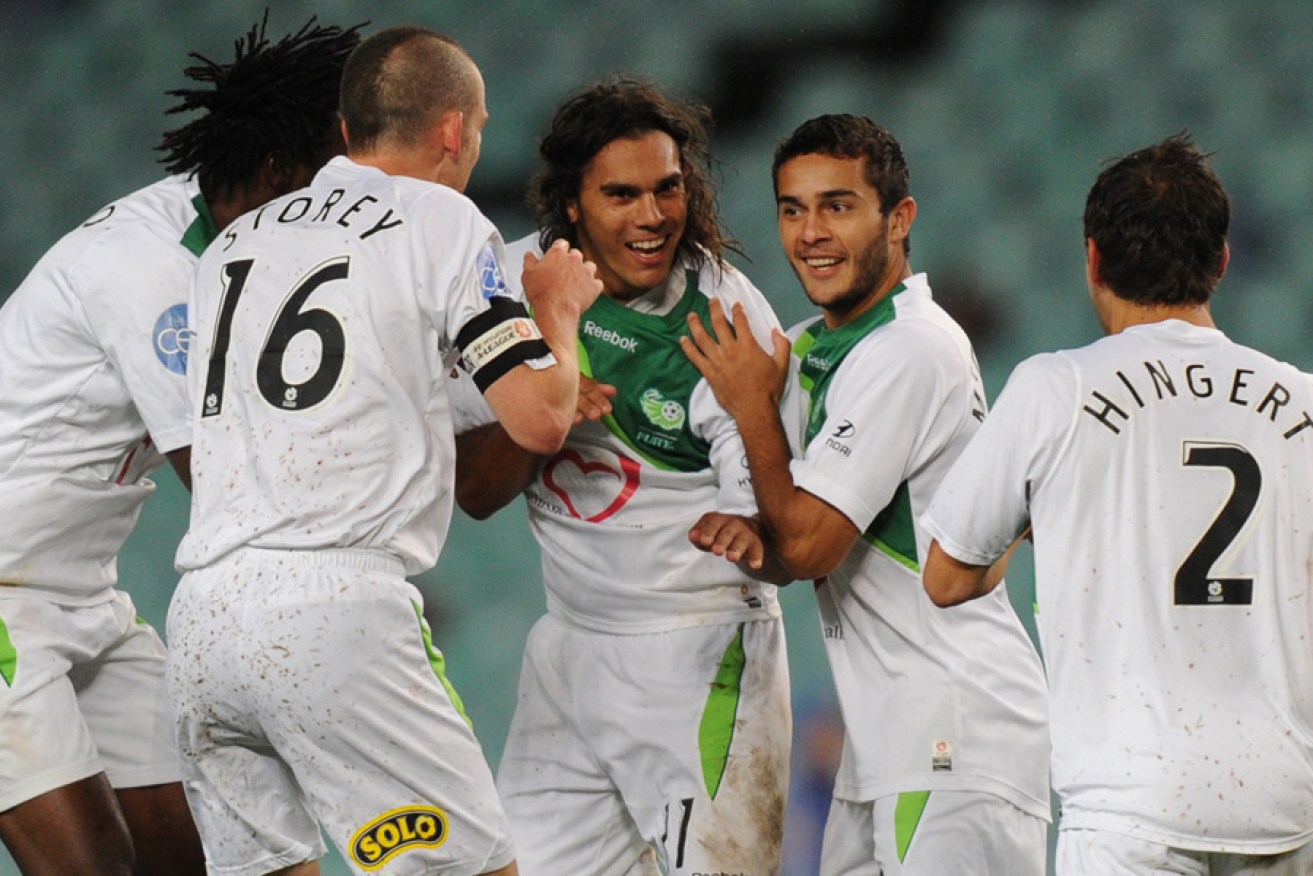Patient Fury plots A-League comeback
While Cairns hosted an A-League match on the weekend, a competition exile has grand plans to bring top-flight soccer to Townsville, as Paul Marcuccitti reveals.

North Queensland Fury players celebrate a goal during their brief A-League tenure.
North Queensland Fury’s participation in the A-League might have been a here-today-gone-tomorrow affair but the club – now Northern Fury – is laying the groundwork for its return.
The new Fury returned to action in the National Premier League (NPL) Queensland, the top state-level competition, in 2013, two years after its A-League existence ended after just two seasons.
Rabieh Krayem, the club’s Chairman, explains the club’s initial A-League failure.
“Not enough due diligence was done, and rather than embrace the football community of the region to get the A-League established they went straight to a business person who didn’t have a connection with the football community,” Krayem told InDaily.
“I think it was a wrong decision at the wrong time.”
Northern Fury is prepared to be patient. In contrast to some A-League franchises that see fielding teams in the National Youth League and the W-League as an annoyance, the Townsville club is prepared to do both as a first step to a full return to the national stage.
“We really need a youth team (in the National Youth League) and we also need a women’s team (in the W-League). For the region of country Queensland, to only have one youth team in the whole state, based in Brisbane, and one W-League team in Brisbane makes a mockery of the ethos of wanting to develop the game, particularly for women’s football. It’s a disgrace.”
Fury’s emphasis is on development, with opportunities for boys and girls as young as nine years.
“We don’t pay our players to play in the NPL – we’d rather spend the money on coaching than trying to win a competition. Our ethos is developing the players.
Krayem is not disheartened by the Football Federation Australia (FFA) preference for expansion clubs to be based in cities with populations in the millions but he believes that its direction will eventually need to change.
“The FFA have made it very, very clear they want the next expansion of the A-League into regions with a million plus population. Now that’s great – they can do that – they can get another two teams but I think, if you want to be a truly national sport, you have to grow,” he said.
“Rugby League has proven it, the AFL has proven it, and when you’ve got a sport like football – with 50 per cent of kids between 6 and 13 playing football – you’ve got to grow the sport.”
The Fury chairman has outlined the club’s ambition to FFA, and he’s determined to show the sport’s governing body that the club has learned lessons from its own history and from other troubled A-League franchises.
“I’ve had discussions with Eric Abrams, the FFA Technical Director, and last year I had discussions with David Gallop (FFA CEO). They’ve been fruitful. They know we’re there; they know where our aspirations are,” he said.
“We’ve got to crawl before we walk. Firstly we’ve got the NPL licence. We’ve built the Fury NPL licence we had three years ago with zero funding – we started from scratch.
“We’re basing it on support from the community and the players themselves (and) we’ve invested a lot in coaching. We’ve got three technical directors working for us. I think we’ve got more technical directors than some A-League clubs.”
Krayem also rejects the idea that the club needs wealthy private owners to back its return.
“For us it’s been about building a grassroots model. I think the … model where you can have ongoing membership and the community own the club is sustainable.
“I still think the model’s wrong by just giving an A-League licence to a region. Grassroots up, build it, (then) let them (prospective teams) earn the right to demand an A-League licence rather than just be given one.
A new stadium close to the Townsville CBD to replace the Willows Sports Complex (currently used by the NRL’s North Queensland Cowboys and used by the Fury in its A-League years) also offers opportunities in the region.
“For football to have a stadium of that magnitude in the north, not only for A-League but also for the experience for the youth league (and) the women’s league, also to attract Olyroos (and) the Matildas to play up there, (will be) a big shot in the arm.”
While the club is clear about its direction, the missing piece is a matching vision from the FFA.
“What we want to be able to do is to set the pathway – rather than someone saying, ‘look you’re going to be in the A-League in two years’, give us a five-year vision,” said Krayem.
“If North Queensland can have an A-league licence in five years, tell us what the hurdles will be and if we can meet that, give us a licence.”
Fury has a good relationship with Cairns-based NPL club Far North Queensland but according to Krayem, Townsville’s location makes it the more likely city for A-League expansion.
“We work very closely with the (Far North Queensland) Heat. There’s no doubt that they’re part of the region,” he said.
“The thing about Townsville (is) it’s the central point. You’ve got Cairns four hours north, you’ve got Mackay four hours south and you’ve got a population of around 400,000 to 500,000 people within a four-and-a-half hour radius. So it just happens that Townsville is the central point.
“I think there’s no doubt there’s only one A-League licence down the track (for northern Queensland) and we’re saying Townsville’s the best place. Simply, we’ve got the geographic location and the support.”




